Jeep’s TrackHawk really DASHES through the snow
By John Gilbert
Maybe it’s because the folks who build Jeeps are cousins to the FCA Group’s Dodge Boys, who keep giving new life to aging — vintage? — sedans, but the engineering crossover happened quicker and more efficiently than crossovers themselves. That’s why we now have something called the Jeep Grand Cherokee Trackhawk — which might be described as the perfect vehicle for somebody who wants to go off-roading extremely fast.
After my first, somewhat breathtaking, exposure to the 707-horsepower Trackhawk, which came on a road-racing track, my biggest question is how would such an enormously overpowered and highly-engineered vehicle work in the real world.
Now, my real-world is based on the North Shore of Lake Superior, up the road a piece from the westernmost point of the big lake, called Duluth. In the Duluth area, we have what you call “winter.” During winter, there is a lot of cold weather, and a lot of snow and ice. Having less power and more traction is usually an asset during the winter months. Finally, I got the chance to adequately test a Grand Cherokee Trackhawk just before Christmastime, and Mother Nature was kind enough to oblige with a nasty little snowstorm, which covered the North Shore with about 6 inches of snow, and then a temperature plunge that want down near zero, just to make it crusty.
The timing was good enough that I could ask my wife, Joan, and sons Jack and Jeff, for a special Christmas gift — a Trackhawk of my own. They rejected my suggestion out of hand. They offered some flimsy excuse like it wouldn’t fit under the Christmas tree, but I knew their reluctance was only because they couldn’t gather up the $90,880 on the sticker for the test vehicle.
Given a choice, every automaker in the world would like to provide what they call complete coverage of whatever segment they are in. Jeep, undoubtedly the most-recognized name in U.S. automobiles, is not immune from that desire, even though Jeep’s segment is comparatively small and well focused.
I mean, the original Jeep was built to go anywhere, particularly over rugged terrain while transporting soldiers or military officials through fields, mountains, streams and every other imaginable surface. So Jeep has excelled at building its Wrangler to do just that, and a surprisingly large gang of hobby off-roaders is forever grateful. Jeep then stretched upward, to build larger vehicles before the term “SUV” came along, and the Grand Cherokee has been a stalwart Sport Utility Vehicle since its inception.
From there, every direction came into play, and Jeep built the Cherokee, which was smaller, or less-grand, than the Grand Cherokee; then various diversionary vehicles, including the Wagoneer, Patriot, Compass, Renegade, and whatever. Finally, Jeep has streamlined itself to fofer the Grand Cherokee, Cherokee, Compass, Renegade, and Wrangler. That must have been where the Jeep engineers realized that their counterparts who build Dodge Chargers and Dodge Challengers, and even a competitive SUV called the Durango, were having a lot more fun than merely bouncing over off-road terrain.
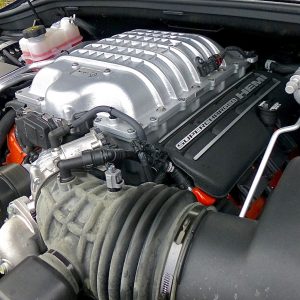
Supercharged 6.2-liter Hemi V8 provides amazingly well-balanced 707-horsepower kick to the Grand Cherokee Trackhawk.
So out of the incredible Dodge Charger and Challenger Hellcats, Jeep got its hands on the same sweet 6.2-liter Hemi V8, with the supercharger sitting up on top of it. They didn’t stop there, loading up the Grand Cherokee with fantastic suspension parts, quad exhaust, and still met the demands of current post-recession consumers who have forgotten entirely the necessity of high mileage for the sake of buying large SUVs with unlimited power and even less limits in sticker price. One amazing feature is that people are buying the costliest large SUVs and paying over $80,000, so Jeep was sure to put all the luxury amenities in the Trackhawk, and once you step hard on the gas, you realize that it has some features that put it above and beyond the competition.
On the exterior, Jeep made the Trailhawk look the specialty part, with special lights, operating hood vents, black alloy wheels and much more restraint in the design contours than they had under the hood. The test vehicle was called Rhino Clear-coat. I guess a Rhino is a flat, understated grey, which is what the Jeep was.
That is not to say it was drab, more like impressive, in a militaristic sort of way. But it was less flashy than the interior, which was a striking, bright Nappa leather color on the seat surfaces of the specially built bucket seats. They are built to be heated or cooled, and the rear seat is also heated. All the technical assets and refinements imaginable are on-board, beyond the adaptive sport suspension that holds the hefty vehicle in perfectly precise flatness. Features such as lane departure, collision, parallel and perpendicular park assist, blind-spot and rear crossing alerts, front collision avoidance, adaptive cruise, and both Apple and Android connectivity.
But we’re not kidding anybody, the attraction of a monster truck is that it is a better monster, and I can’t think of a competitor — even at similar $90,000 price ranges — that can run with this puppy.
The supercharger gives out a wonderful whine as the engine revs, which is quickly, and I love steering-wheel mounted shift paddles, but I found them to be almost superfluous in the Trackhawk, because if you accelerate hard, the 8-speed automatic shifts itself precisely at just shy of the 6,000-RPM figure. If you want to show somebody how it works, hit it, let it shift a couple of times, and then get off the power, because you’ll be going 85.
Jeep folks claim the Trackhawk will go 0-60 in 3.5 seconds. I wouldn’t argue with that. I always have been a fan of smaller and more compact SUVs, because smaller engines can make them work with great pep, and you might get 25-30 miles per gallon. The Trackhawk might reach 17 in highway driving, according to EPA estimates, which suggest 11 in city driving.
The comfort, support, and solid feel make you feel extremely secure in any conditions, and we had any conditions.
The big wheels show off enormous Brembo brakes that do a great job of hauling down the Trackhawk. The list of features also pointed out that the “stock” Trackhawk comes with all-season tires mounted on the 20×10 inch wheels, but the option list on this particular Trackhawk swapped out those all-seasons for “3 season” tires, on black satin wheels. The wheels were a $995 option, and the 3-season tires were an $895 option, which assured you of less traction once the snowstorm hit and lined the roadways with slippery stuff.
The Trackhawk worked, naturally, and made it pleasant along the way thanks to the 825-watt Harmon Kardon amplifier and subwoofer blasting through 19 speakers. That didn’t help our traction, but having all four wheels working was a great aid, especially through Jeep’s Quadra-Trac active on-demand 4-wheel-drive system with Selec-Track.
What was most-appreciated after the snowfall and temperature plunge was remote start. Hit the key fob button twice, the lights blink in response, and the big Hemi roars to life and gets you a head start on your heated steering wheel and seats.
If I were to get a Trackhawk for Christmas, I would prefer the all-season tires, and in fact my favorite Nokian all-seasons would be ideal. It might slow your 0-60 times from 3.5 to, maybe, 4 seconds, but you could scale the cliffside avenues of Duluth, surprise snowstorms or not.
dashes


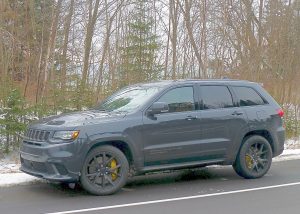
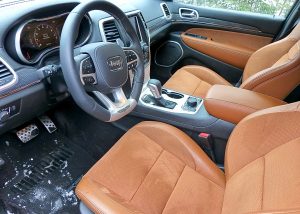
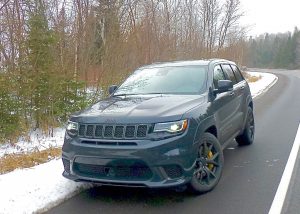
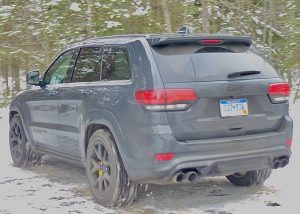

 John Gilbert is a lifetime Minnesotan and career journalist, specializing in cars and sports during and since spending 30 years at the Minneapolis Tribune, now the Star Tribune. More recently, he has continued translating the high-tech world of autos and sharing his passionate insights as a freelance writer/photographer/broadcaster. A member of the prestigious North American Car and Truck of the Year jury since 1993. John can be heard Monday-Friday from 9-11am on 610 KDAL(www.kdal610.com) on the "John Gilbert Show," and writes a column in the Duluth Reader.
John Gilbert is a lifetime Minnesotan and career journalist, specializing in cars and sports during and since spending 30 years at the Minneapolis Tribune, now the Star Tribune. More recently, he has continued translating the high-tech world of autos and sharing his passionate insights as a freelance writer/photographer/broadcaster. A member of the prestigious North American Car and Truck of the Year jury since 1993. John can be heard Monday-Friday from 9-11am on 610 KDAL(www.kdal610.com) on the "John Gilbert Show," and writes a column in the Duluth Reader.